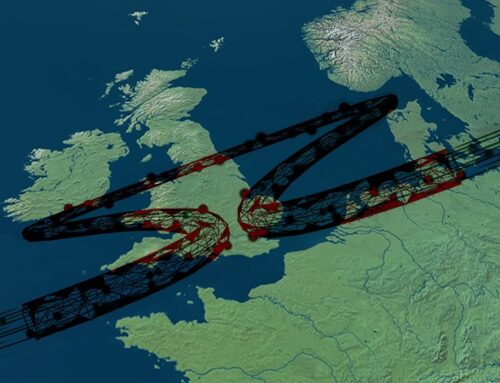Last week I participated in a webinar hosted by Energy Live News on how the covid-19 on users, brokers and suppliers, which covered some interesting points not mentioned in my previous post on the subject.
Market liquidity on the prompt is largely unchanged
Gas and power prices have been lower in 2020 than last year due to weaker fundamentals, and the covid-19 crisis has pushed them lower still as demand has declined significantly since the start of the lockdown, falling by around 10% almost overnight.
This reduction is being seen across the energy complex. Brent crude futures prices for May 2020 trading on ICE started last month with a monthly maximum settlement price of US$51.90 /bbl on 2 March, but fell throughout the month to reach the monthly minimum settlement price of US$22.74 /bbl on 31 March – a decrease of 56%, and the lowest settlement price registered for this product at least since spring 2014. The monthly average price was US$33.73 /bbl, 50% lower than the corresponding price in March 2019, of US$67.03 /bbl.
The decline was driven by the effects of the coronavirus, but also an emerging trade war between Russia and Saudi Arabia with both countries announcing their intention to significantly increase production in April against a backdrop of low demand and limited storage capacity.
April 2020 TTF gas futures trading on ICE reached a monthly maximum settlement price of €9.37 /MWh on 11 March, and fell to a minimum of €6.90 /MWh on 30 March, the lowest level in 5 years. In the spot markets, TTF prices saw a maximum of €9.56 /MWh on 16 March, falling to €7.12 /MWh on 31 March, and fell further in April to lows not seen since October 2008.
The API 2 coal futures prices on ICE for April 2020 remained stable at around US $47.78 /t in the first twelve days of the month, rising to US$54.45 /t on 25 March but then falling to US$49.30 /t on 31 March. The price increases in the second half of March were due partly to fears that the coronavirus might lead to mine and port closures that would disrupt supplies, at the same time that industrial production in China began to ramp up again. However, supply was maintained and prices fell back.
“Already from the beginning of the year wholesale electricity prices were lower due to global dynamics on oil and gas markets. The coronavirus has exacerbated that impact on wholesale power prices…Demand [for power] is likely going to lower during this period due to the lockdowns, so that’s fewer customers for suppliers. And as people start getting behind on bills there will be more collection issues that suppliers will experience. So trading for suppliers will be challenging for those reasons, which translates into more overhead costs for the remaining consumers,”
– Felix Chow-Kambitsch, Aurora Energy Research
Larger suppliers with active hedging programmes will be now be facing negative mark-to-markets as prices have fallen across the curve, and are comparatively lower than at the same time last year. Falling demand also means that suppliers may find themselves over-hedged. Lower prices do however, provide some relief for smaller suppliers that typically lack the capabilities to lock in forward prices and are buying now in a falling spot market.


The desire to unwind uneconomic hedges is challenging for two reasons… the first is that most market participants are axed in the same direction which pushes further downward pressure on prices, and the other is a lack of clarity around when demand and prices might recover – trades with negative carry are costly, but so is re-hedging or being un-hedged in a rising market.
Electricity markets are typically less liquid than gas markets (and both are less liquid than oil), and liquidity is stronger at the short end of the forward curve. The current crisis has seen longer-dated products become less liquid, but there has been little impact at the day-ahead level, which is entirely understandable given the uncertainty about the speed with which life might return to normal after this crisis.

When re-evaluating hedging portfolios, suppliers need to consider
- What are their revised volume expectations and are they over-hedged in some parts of the curve?
- What is the cost of unwinding those hedges versus selling the long position into the market at maturity?
- What is the liquidity impact of margin calls on hedges?
- What are the hedging policies set out by the board: are speculative positions prohibited; is more flexibility needed in the short term?
Force majeure is not necessarily an obvious way of avoiding business obligations
Another key area of interest was around force majeure and whether the use of force majeure provisions in contracts could provide relief to energy market participants. A claim of force majeure provides a number of benefits in that the affected contractual obligations are temporarily suspended while the force majeure event persists. Liabilities arising from any non-performance of the party’s contractual obligations during this time are extinguished. There might be termination rights associated with force majeure, or the contract could be automatically discharged with the parties having no further obligations to each other.
This is obviously an area that legal teams will be analysing in some detail, but there are no particular general rules: force majeure provisions differ from contract to contract depending on how they are drafted. As there is no specific definition of the term in English law its applicability is solely determined by the wording of each individual contract. As explained here, in order for force majeure to be enforceable it must be defined in the contract – simply referencing it would not be enough to allow a party to enforce it.
In determining whether a force majeure could be claimed by a party, the following need to be considered:
- The definition of force majeure within the contract and whether those conditions are met;
- Whether a causal link can be shown between the force majeure event and non-performance under the contract;
- Whether the party has taken reasonable steps to mitigate the effects of the force majeure event;
- Whether the requirements to notify the other party of the force majeure event have been met.
If a party claims force majeure incorrectly, it risks facing a claim for breach of contract with the costs in both financial and administrative terms that that would involve.
It can be tempting to view a pandemic as a prime example of a force majeure event – the coronavirus crisis could reasonably considered to be an “act of God” and some contracts explicitly include a pandemic as a force majeure event. However, the question is around the extent to which that leads to non-performance under energy contracts, and as many businesses are continuing to operate, albeit in a scaled-down form, it might be difficult to demonstrate. It is also potentially undesirable for large numbers of contracts to be cancelled, since contracts form the basis of economic activity.
What should businesses do to navigate the covid-19 crisis?
This is a challenging time for the energy sector. I described the challenges facing suppliers in my previous post, although there are some contractual protections they tend to have in their dealings with business consumers that do not tend to apply at the domestic level.
However, their ability to rely on these provisions will be limited by the ability of businesses to fulfil them. For example, suppliers often have the right to charge business customers more if they do not have direct debits in place, so those companies that have cancelled direct debits for cash-flow reasons could technically face higher charges, but if they are unable to meet their payment obligations, these provisions become moot. Contracts often also contain volume provisions, so businesses may find themselves penalised if their volumes are lower than anticipated in their supply agreements.
The key advice to businesses is to understand their contractual obligations in detail, to re-assess their likely volume requirements, and to communicate these to suppliers, as well as discussing any concerns about affordability of their energy bills and network connection charges.
Suppliers are typically prioritising the needs of vulnerable consumers, and will be dealing with very high numbers of customer enquiries at a time when staffing levels might be lower due to sickness or the need to self-isolate. Helping suppliers to understand what the demand across their portfolio will help them to manage their own liquidity positions, and understanding to what extent they can expect payment delays or delinquency will help them to assess what if any support they will need from the Government in order to continue their own operations.
Many of these challenges are reflected across the economy as a whole. The overall impact can only be managed through good communication between market participants, and to trade bodies that will be lobbying the Government for support packages, which will help the Government structure that support in the most effective way.
A recording of the discussion can be found here.






It was drawn to my attention that the fastest growing retailer has been Bulb Energy. Their business model appears to be to simplify to cut costs, so they do not offer a range of fancy tariffs and fixes – just one variable rate tariff that requires essentially no forward hedging – just management of short term obligations in the market to minimise BSUoS charges. Of course, they would be vulnerable in a rising market (and we have at least seen some modest rebound in hydrocarbon prices in recent weeks), but the rising frequency of renewables surplus generation may reduce the impact of that. Managing rising price volatility in the short term is a problem for all market participants, and many of their models will need re-casting to deal with negative prices.
It’s a good strategy but from a competition perspective it still has a couple of drawbacks neither of which can really be controlled by Bulb. One is that the bigger players forward hedge so have more revenue stability. I have some doubts that even with SVT, DA price volatility is efficiently passed through to customers, and intraday volatility is a whole other ball game.
The other issue is that suppliers that don’t hedge only really have control over around 20% of their cost base which arguably is too low to create room for meaningful competition – within this all suppliers have to implement effective billing systems, meter reading and so on. A single tariff operating model is probably the best way to keep the back office ops simple and cost-effective, so I can see this being a decent strategy, but most suppliers have traditionally used low-fixed rate tariffs to win new customers, subsidised by more expensive SV tariffs. Bulb runs the risk that some consumers will just hop from fixed rate to fixed rate locking in the loss-leading deals suppliers use to entice new business. They would only offset that if their simple back office model resulting in a significantly enhanced consumer experience eg fewer billing errors, more responsive call centre staff.
It’s an interesting approach though.
A bit more research suggests that they may crash and burn: losses of £129m on turnover of £823m doesn’t sound like a basis for longer term survival.
https://www.current-news.co.uk/news/bulb-net-loss-surges-to-129-million-as-revenues-and-members-rise
You have to wonder whether OFGEM has any financially competent staff. I think they awarded Bulb a number of customers from bankrupted suppliers recently.